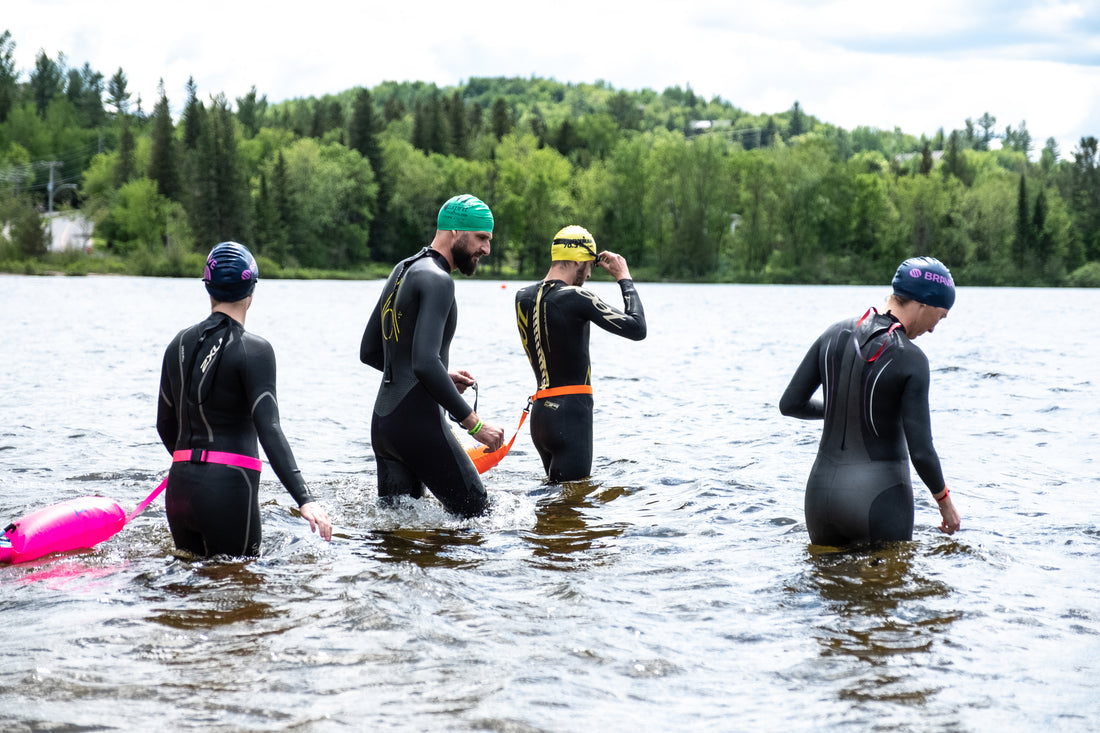Swimming is the most complex discipline to tackle for many triathletes who are not experienced swimmers. Start line stress and the particularities of swimming in open water give it its unique character: we are afraid of it, but at the same time, consciously or unconsciously, it is for this challenge that we chose triathlon.
So how do you prepare?
Consistency and specificity in your swim training
Ideally, incorporate 2 to 3 swim trainings/week incorporating the following 3 principles:
- Technique: incorporate specific drills to improve your efficiency in the water. Think of the person in the fast lane who seems to have half your muscle mass, but who blazes by you seemingly effortlessly.
- Threshold/Critical Swim Speed (CSS) Training: swim at a speed that allows you to put the technical work into practice while developing your muscular strength and cardio.
- Endurance: regular 2000 to 4000-meter swim sessions (depending on your discipline) is essential: otherwise your technique will derail halfway through your race day swim. You may consume a lot of energy even before the bike starts, making your day longer than anticipated.
Learn more about these principles in our previous blogs on technique and swim fitness.
Do intervals rather than continuous swimming
In the pool, swimming 1900m or 3800m continuously may be interesting from a mental strength point of view ("I can do the distance") but is not very effective.
Swimming is a very technical sport: rather than swimming 2000m continuously, 5x400m at a faster pace, with shorter recovery, time to reset and practice your technique will pay off more.
Learn to control your pace
Just like a marathon, one of the biggest mistakes in long distance swimming is to start too fast. Learn how to manage your pace with a Tempo Trainer, pool clock or your watch.
Specific work for open water
- Your pool training must include specific triathlon work. Get used to following other swimmers and even passing them. Alternate your breathing from side to side, 5 arm strokes, 2-3-2, etc. Vary your pace to simulate a start by accelerating at the start while being able to comfortably resume your endurance pace.
- Whether in a lake or a pool, it is essential to test your wetsuit. The first few times, you can feel a bit compressed, so don’t wait until race day.
- Familiarize yourself with the different facets of open water swimming: Cold, dark water, algae or the presence of fish can cause a lot of anxiety that may affect your breathing.
- Complete the full distance in open water at least once, if possible at the time of your race start to simulate race day.
- To help decrease anxiety, sign up for a training camp, open-water swim competition or group swim before race day. The body tends to react differently in race situations or in groups.
Race day
Before the race:
- Get familiar with the swim course: find a fixed landmark to orient yourself, think about the sun's orientation and depth of the water at the entry and exit (depending on the water level, it is often more efficient to swim than to walk).
- If your race has wetsuit "strippers" note where they will be.
- Plan the right materials: Tinted or clear glasses? Neoprene cap if the water is very cold, anti-friction cream to prevent chaffing and facilitate wetsuit removal.
- Warm up in the water before your start: in addition to activating your muscles and cardio, you will avoid the "shock" of getting wet on departure. It's also a good time to put yourself in your bubble.
Durring the swim:
Choose a strategic position
If you are too modest, you will have to pass many athletes, but if you overestimate your level, you risk being swum over by faster swimmers. A good option is to position yourself on the sides. You wont gain much draft advantage, and you may end up swimming a few extra meters, but you will also be in a calmer spot and swim at your own pace without much interruption. If you are a beginner and more stressed, better to slightly under than overestimate your pace.
Adopt the right attitude
Remember to keep calm and swim on! If the water is turbulent and you feel like you’re in an eggbeater, or you take a hit from a fellow athlete, tell yourself that it surely wasn’t on purpose. Stay calm and focused on your swim.
Save your energy
Studies show that you can save 15 to 20% of your energy by "drafting" effectively. It can be difficult to assess whether you are faster solo or behind another swimmer. Here are 2 good clues:
1- You swim side by side with another swimmer for ~5 minutes: be smart, place yourself behind them. You can then pass them towards the end if you feel the need to satisfy your ego!
2- You are slowly overtaken by another triathlete: try to follow them by increasing your pace very slightly. Be careful not to touch your new friend’s feet (no one likes this!). After all, they are pulling you so be discreet.
Don’t add unnecessary distance
Sighting is essential. If you take a wrong direction, you can very quickly add 100 to 200m to your course. The few minutes gained thanks to your rigorous winter training will then dissapear! Use sighting techniques frequently. A quick glance in "crocodile" mode (just the eyes come out of the water) every 6 to 10 strokes will be enough to validate your direction.
The end of the swim
At the end of the swim, intensify your kick to reduce dizziness when you stand.
Swim until your arms touch the bottom, it's much easier to swim than run in shallow water.
If there are wetsuit "stripers" to help you take off your wetsuit, take advantage of it and do not forget to thank them alongside all the other volunteers you will cross throughout the day 😊
Finally, think about smiling for your fans and supporters. They are here to see you and please you. If you have taken shots, lost your goggles, swam off course or had a longer swim time than you hoped, it doesn’t matter anymore. Stay positive, focus on your transition and the upcoming disciplines.
The day is not over, so enjoy the rest of the dance!
Bart Rolet
Swim Smooth Montreal




